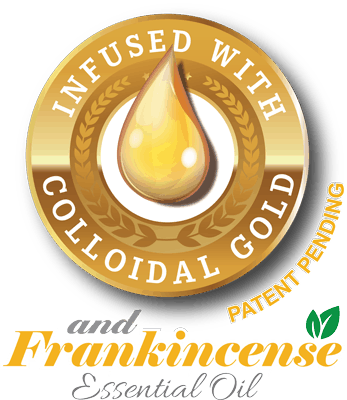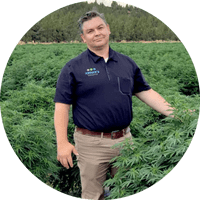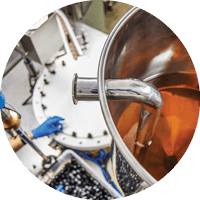Why Nature’s Aid?
Straight from the Farm to You. We source our CBD Hemp Extract from our farms from rich soil of Oregon
Our industrial hemp is extracted and processed in accordance with the Utah Department of Agriculture.
• Full spectrum (up to 0.3% THC)
• No pesticides, herbicides,
• synthetics, or fillers
• Non GMOs
• Gluten Free
• CO₂ extracted at our ISO-certified facility
We bottle, blend and formulate at our GMP-certified facility
3rd party testing. Each product comes with a Certificate of Analysis (found on-line) which guarantees the quality consistency and accuracy. This gives you the faith that what you are buying has the Hemp Extract levels indicated, the legal THC levels, and peace of mind.

Propriety blends made with Colloidal Gold & Frankincense
Colloidal gold, in skincare products, may allow the active ingredients to penetrate faster and deeper into the skin. Colloidal gold may play a major role in your skincare regimen. Colloidal gold may be crucial in protecting your skin from unnecessary cellular aging. It may be a great source of skin nourishment and an anti-inflammatory. Gold is a natural antioxidant which might have a calming effect to help one manage stress. It may accelerate blood circulation which may help the body to heal faster.*
Frankincense in Skin Care
Frankincense, in skincare, is known to be an antiseptic as well as a disinfectant agent. Possible benefits may include: strengthening and toning the skin, improving the elasticity of the skin, reducing the appearance of wrinkles, scars, age spots, and stretch marks, a defense mechanism against bacteria or blemishes, healing dry and/or cracked skin, and may promote wound healing. Frankincense essential oil is also known to possibly help reduce skin irritations and redness.*

Glen Miner
Nature’s Aid Master Formulator
(doTerra’s original blender & filler)
Our Essential Oil Background
Our team of formulators have over 20 years of creating essential oils blends, skincare, and indigestible formulations for the leading essential oil brands such as doTerra, Young Living, NOW Foods and others.
Our Process
We grow our product in our fields in Oregon, CO2 process the product and formulate and blend it ourselves. This allows our prices to be much lower and have better quality control standards.

Our Facility
We have a 50,000 s/f facility, in Utah, which is licensed by the FDA, USDA organic, GMP and ISO certified
Our Testing
Each CBD product is 3rd Party Tested and has a COA certificate posted on our website.
*These statements have not been evaluated by the Food and Drug Administration. This product is not intended to diagnose, treat, cure, or prevent any disease.
References
Please see the listed resources below to learn more about CBD and it’s benefits.
Zachary Wilmer Reichenbach and Ron Schey, “Cannabinoids and GI Disorders: Endogenous and Exogenous,” Current Treatment Options in Gastroenterology 14, no. 4 (2016): 461–477. doi:10.1007/s11938-016-0110.
Bradley E. Alger, “Getting High on the Endocannabinoid System,” Cerebrum: The Dana Forum on Brain Science (2013): 14.
Yann LeStrat and Bernard Le Foll, “Obesity and Cannabis Use: Results From 2 Representative National Surveys,” American Journal of Epidemiology 174, no. 8 (2011): 929–933. doi:10.1093/aje/kwr200.
L. Weiss, M. Zeira, S. Reich, M. Har-Noy, R. Mechoulam, S. Slavin, and R. Gallily, “Cannabidiol Lowers Incidence of Diabetes in Non-obese Diabetic Mice,” Autoimmunity 39, no. 2 (2006): 143–151.
Abigail Klein Leichman, “Cannabis Extract to Be Used to Treat Diabetes,” Israel 21c, April 21, 2015, www.israel21c.org/cannabis-extract -to-be-used-to-treat-diabetes/.
H. J. Parray and J. W. Yun, “Cannabidiol Promotes Browning in 3T3-L1 Adipocytes,” Molecular and Cellular Biochemistry 416 (2016): 131–139.
E. A. Penner, H. Buettner, and M. A. Mittleman, “Marijuana Use on Glucose, Insulin, and Insulin Resistance among US Adults,” American Journal of Medicine 126 (2013): 583–589.
Sabine Steffens, Niels R. Veillard, Claire Arnaud, Graziano Pelli, Fabienne Burger, Christian Staub, Andreas Zimmer, Jean-Louis Frossard, and François Mach, “Low Dose Oral Cannabinoid Therapy Reduces Progression of Atherosclerosis in Mice,” Nature 434 (2005): 782–786.
Francois Mach and Sabine Steffens, “The Role of the Endocannabinoid System in Atherosclerosis,” Journal of Neuroendocrinology 20, no. S1 (2008): 53–57. doi:10.1111/j.1365-2826.2008.01685.x.
Mauro Maccarrone, Itai Bab, Tamás Bíró, Guy A. Cabral, Sudhansu K. Dey, Vincenzo Di Marzo, Justin C. Konje, George Kunos, Raphael Mechoulam, Pal Pacher, Keith A. Sharkey, and Andreas Zimmer, “Endocannabinoid Signaling at the Periphery, 50 Years after THC,” Cell: Trends in Pharmacological Science 36, no. 5 (May 2015): 277–296.
Sabine Steffens and Francois Mach, “Cannabinoid Receptors in Atherosclerosis,” Current Opinion in Lipidology 17, no. 5 (2006): 519–526. doi:10.1097/01.mol.0000245257.17764.b2.
[185] Ronen Durst, Haim Danenberg, Ruth Gallily, Raphael Mechoulam, Keren Meir, Etty Grad, Ronen Beeri, Thea Pugatsch, Elizabet Tarsish, and Chaim Lotan, “Cannabidiol, A Nonpsychoactive Cannabis Constituent, Protects against Myocardial Ischemic Reperfusion Injury,” American Journal of Physiology – Heart and Circulatory Physiology 293, no. 6 (2007): H3602–H3607. doi:10.1152/ajpheart.00098.2007.
John C. Ashton and Paul F. Smith, “Cannabinoids and Cardiovascular Disease: The Outlook for Clinical Treatments,” Current Vascular Pharmacology 5, no. 3 (2007): 175–184. doi:10.2174/157016107781024109.
Gabriella Aviello, Barbara Romano, Francesca Borrelli, Raffaele Capasso, Laura Gallo, Fabiana Piscitelli, Vincenzo Di Marzo, and Angelo A. Izzo, “Chemopreventive Effect of the Non-psychotropic Phytocannabinoid Cannabidiol on Experimental Colon Cancer,” Journal of Molecular Medicine 90, no. 8 (2012): 925–934. doi:10.1007/s00109-011-0856-x.
“NTP Toxicology and Carcinogenesis Studies of 1-Trans-Delta(9)- Tetrahydrocannabinol (CAS No. 1972-08-3) in F344 Rats and B6C3F1Mice (Gavage Studies),” National Toxicology Program Technical Report Series 446 (1996): 1–317.
A. A. Thomas, L. P. Wallner, V. P. Quinn, J. Slezak, S. K. Van Den Eeden, G. W. Chien, and S. J. Jacobsen, “Association between Cannabis Use and the Risk of Bladder Cancer: Results from the California Men’s Health Study,” Urology 85, iss. 2 (2015): 388–393.
Andras Bilkei-Gorzo, “The Endocannabinoid System in Normal and Pathological Brain Ageing,” Philosophical Transactions of the Royal Society of London 367, no. 1607 (2012): 3326–3341. doi:10.1098/rstb.2011.0388.
J. Fernández-Ruiz, O. Sagredo, M. R. Pazos, C. García, R. Pertwee, R. Mechoulam, and J. Martínez-Orgado, “Cannabidiol for Neurodegenerative Disorders: Important New Clinical Applications for This Phytocannabinoid?” British Journal of Clinical Pharmacology 75, no. 2 (May 25, 2012): 323–333.
Gary L. Wenk, “Animal Models of Alzheimer’s Disease,” Animal Models of Neurological Disease I (1992): 29–64, doi:10.1385/0-89603-208-6:29.
N. M. Kogan, E. Melamed, E. Wasserman, B. Raphael, A. Breuer, K. S. Stok, R. Sondergaard, A. V. Escudero, S. Baraghithy, M. Attar-Namdar, S. Friedlander-Barenboim, N. Mathavan, H. Isaksson, R. Mechoulam, R. Müller, A. Bajayo, Y. Gabet, and I. Bab, “Cannabidiol, A Major Nonpsychotropic Cannabis Constituent, Enhances Fracture Healing and Stimulates Lysyl Hydroxylase Activity in Osteoblasts,” Journal of Mineral and Bone Research 30, no. 10 (October 2015): 1905–1913.
A. J. Hampson, M. Grimaldi, J. Axelrod, and D. Wink, “Cannabidiol and (−)∆9-Tetrahydrocannabinol Are Neuroprotective Antioxidants,” Proceedings of the National Academy of Sciences of the United States of America 95, no. 14 (1998): 8268–8273.
N. Dobrosi, B. I. Toth, G. Nagy, A. Dozsa, T. Geczy, L. Nagy, C. C. Zouboulis, R. Paus, L. Kovacs, and T. Biro, “Endocannabinoids Enhance Lipid Synthesis and Apoptosis of Human Sebocytes via Cannabinoid Receptor-2-Mediated Signaling,” The FASEB Journal 22, no. 10 (2008): 3685– 3695. doi:10.1096/fj.0604877.
G. A. Grierson, “The Hemp Plant in Sanskrit and Hindi Literature,” Indian Antiquary (September 1894): 260–262.
A. R. Schier, N. P. Ribeiro, A. C. Silva, J. E. Hallak, J. A. Crippa, A. E. Nardi, and A. W. Zuardi, “Cannabidiol, a Cannabis sativa Constituent, As an Anxiolytic Drug,” Revista Brasileira de Psiquiatri 34, suppl. 1 (2012): S104–S110. PubMed PMID: 22729452.
R. J. Bluett, J. C. Gamble-George, D. J. Hermanson, N. D. Hartley, L. J. Marnett, and S. Patel, “Central Anandamide Defciency Predicts StressInduced Anxiety: Behavioral Reversal through Endocannabinoid Augmentation,” Translational Psychiatry 8, no. 4 (2014): e408. doi:10.1038/ tp.2014.53.
A. C. Campos, Z. Ortega, J. Palazuelos, M. V. Fogaça, D. C. Aguiar, J. Díaz-Alonso, S. Ortega-Gutiérrez, H. Vázquez-Villa, F. A. Moreira, M. Guzmán, I. Galve-Roperh, and F. S. Guimarães, “The Anxiolytic Effect of Cannabidiol on Chronically Stressed Mice Depends on Hippocampal Neurogenesis: Involvement of the Endocannabinoid System,” International Journal of Neuropsychopharmacology 16, no. 6 (2013): 1407–1419. doi:10.1017/S1461145712001502.
McGill University, “Cannabis: Potent Anti-depressant In Low Doses, Worsens Depression At High Doses,” ScienceDaily, October 24, 2007.
M. N. Hill, C. J. Hillard, F. R. Bambico, S. Patel, B. B. Gorzalka, and G. Gobbi, “The Therapeutic Potential of the Endocannabinoid System for the Development of a Novel Class of Antidepressants,” Trends in Pharmacological Sciences 30, no. 9 (2009): 484–493. doi:10.1016/j.tips.2009.06.006.
R. Linge, L. Jiménez-Sánchez, L. Campa, F. Pilar-Cuéllar, R. Vidal, A. Pazos, and A. Adell Díaz, “Cannabidiol Induces Rapid-Acting Antidepressant-Like Effects and Enhances Cortical 5-HT/Glutamate Neurotransmission: Role of 5-HT1A Receptors,” Neuropharmacology 103 (2016): 16. doi:10.1016/j.neuropharm.2015.12.017.
Samir Haj-Dahmane and Roh-Yu Shen, “Endocannabinoid Signaling and the Regulation of the Serotonin System,” in Endocannabinoid Regulation of Monoamines in Psychiatric and Neurological Disorders, ed. Elisabeth J. Van Bockstaele (New York: Springer, 2013), 239–254. doi:10.1007/977-4614-7940-6_11.
M. N. Hill, C. J. Hillard, F. R. Bambico, S. Patel, B. B. Gorzalka, and G. Gobbi, “The Therapeutic Potential of the Endocannabinoid System for the Development of a Novel Class of Antidepressants,” Trends in Pharmacological Sciences 30, no. 9 (2009): 484–493. doi:10.1016/j.tips.2009.06.006.
C. H. Ashton, P. B. Moore, P. Gallagher, and A. H. Young, “Cannabinoids in Bipolar Affective Disorder: A Review and Discussion of Their Therapeutic Potential,” Journal of Psychopharmacology 19, no. 3 (2005): 293–300.
A. Zuardi, J. Crippa, S. Dursun, S. Morais, J. Vilela, R. Sanches, and J. Hallak, “Cannabidiol Was Ineffective for Manic Episode of Bipolar Affective Disorder,” Journal of Psychopharmacology 24, no. 1 (2010): 135– 137. doi:10.1177/0269881108096521.
Abir T. El-Alfy, Kelly Ivey, Keisha Robinson, Safwat Ahmed, Mohamed Radwan, Desmond Slade, Ikhlas Khan, Mahmoud ElSohly, and Samir Ross, “Antidepressant-Like Effect of ∆9-tetrahydrocannabinol and Other Cannabinoids Isolated from Cannabis sativa,” Journal of Pharmacology, Biochemistry and Behavior 95, no. 4 (June 2010): 434–442.
A. R. de Mello Schier, N. P. de Oliveira Ribeiro, D. S. Coutinho, S. Machado, O. Arias-Carrión, J. A. Crippa, A. W. Zuardi, A. E. Nardi, and A. C. Silva, “Antidepressant-Like and Anxiolytic-Like Effects of Cannabidiol: A Chemical Compound of Cannabis sativa,” CNS Neurol Disorders – Drug Targets 13, no. 6 (2014): 953–960.
J. Russell Reynolds, “On Some of the Therapeutical Uses of Indian Hemp,” in Archives of Medicine, vol. 2 (London, 1859), 154.
R. Greco, V. Gasperi, M. Maccarrone, and C. Tassorelli, “The Endocannabinoid System and Migraine,” Experimental Neurololgy 224, no. 1 (2010): 85–91. doi:10.1016/j.expneurol.2010.03.029.
Ethan Russo and Andrea Hohmann, “Role of Cannabinoids in Pain Management,” in Comprehensive Treatment of Chronic Pain by Medical, Interventional and Integrative Approaches, ed. Timothy R. Deer et al. (New York: Springer, 2013), 181–197.
“Testimonials,” No High CBD Oil, last modifed March 8, 2017, http:// nohighcbdoil.weebly.com/testimonials.html.
E. B. Russo, “Cannabinoids in the Management of Diffcult to Treat Pain,” Journal of Therapeutics and Clinical Risk Management 4, no. 1 (2008): 245–259.
S. Maione, F. Piscitelli, L. Gatta, D. Vita, L. De Petrocellis, E. Palazzo, V. de Novellis, and V. Di Marzo, “Non-psychoactive Cannabinoids Modulate the Descending Pathway of Antinociception in Anaesthetized Rats through Several Mechanisms of Action,” British Journal of Phramacology 162, no. 3 (2011): 584. doi:10.1111/j.1476-5381.2010.01063.x.
W. Xiong, T. Cui, K. Cheng, F. Yang, S. R. Chen, D. Willenbring, Y. Guan, H. L. Pan, K. Ren, Y. Xu, and L. Zhang, “Cannabinoids Suppress Infammatory and Neuropathic Pain by Targeting α3 Glycine Receptors,” Journal of Experimental Medicine 209, no. 6 (2012): 1121–1134. doi:10.1084 /jem.20120242.
M. DeGeorge, E. Dawson, P. Woster, L. Burke, and K. Bronstein, An Analysis of the Association between Marijuana Use and Potential Nonadherence in Patients Prescribed Hydrocodon (Baltimore: Ameritox, 2013), www.ameritox .com/wp-content/uploads/Ananalysisoftheassociationbetweenmarijua nauseandpotentialnonadherence_AAPM2013.pdf.
E. Murillo-Rodríguez, D. Millán-Aldaco, M. Palomero-Rivero, R. Mechoulam, and R. Drucker-Colín, “The Nonpsychoactive Cannabis Constituent Cannabidiol Is a Wake-Inducing Agent,” Behavioral Neuroscience 122, no. 6 (2008): 1378–1382.
D. W. Carley, S. Paviovic, M. Janelidze, and M. Radulovacki, “Functional Role for Cannabinoids in Respiratory Stability during Sleep,” Sleep 25, no. 4 (2002): 391–398. PubMed PMID: 12071539.
Bharati Prasad, Miodrag G. Radulovacki, and David W. Carley, “Proof of Concept Trial of Dronabinol in Obstructive Sleep Apnea,” Frontiers in Psychiatry 4 (2013): 1.
E. B. Russo, G. W. Guy, and P. J. Robson, “Cannabis, Pain, and Sleep: Lessons from Therapeutic Clinical Trials of Sativex, a Cannabis-Based Medicine,” Chemistry and Biodiversity 4, no. 8 (2007): 1729–1743.
M. H. N. Chagas, A. L. Eckeli, A. W. Zuardi, M. A. Pena-Pereira, M. A. Sobreira-Neto, E. T. Sobreira, M. R. Camilo, M. M. Bergamaschi, C. H. Schenck, J. E. C. Hallak, V. Tumas, and J. A. S. Crippa, “Cannabidiol Can Improve Complex Sleep-Related Behaviours Associated with Rapid Eye Movement Sleep Behaviour Disorder in Parkinson’s Disease Patients: A Case Series,” Journal of Clinical Pharmacy and Therapeutics 39 (2014): 564–566. doi:10.1111/jcpt.12179.

